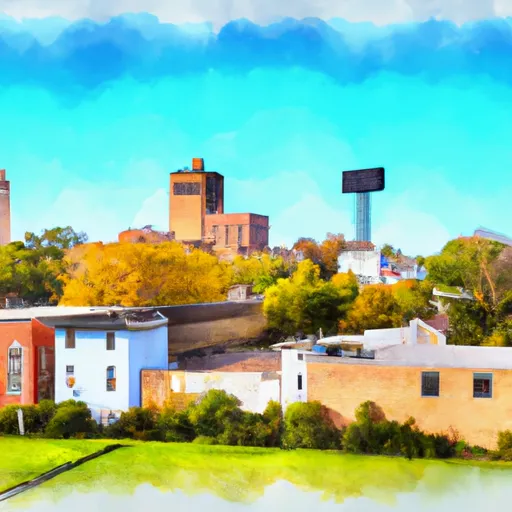-
 Snoflo Premium
Snoflo Premium
Get unlimited access to all our content
With no Ad interruptions! - Start Your Free Trial Login with existing account
Savanna
Eden Index
Climate
7.4
•
Recreation
2.8
•
Community
1.7
•
Safeguard
4.4/10

Savanna, Illinois is a charming city located in Carroll County, situated along the Mississippi River. The climate in Savanna is characterized by four distinct seasons. Winters are cold, with temperatures often dropping below freezing, while summers are warm and humid, ranging from mild to hot. Spring and autumn offer pleasant temperatures, making them ideal for outdoor activities.
As for hydrology constituents, the Mississippi River plays a significant role in Savanna. It not only provides scenic beauty but also offers various recreational opportunities such as boating, fishing, and swimming. There are also several small lakes and ponds in the area that add to the water-based activities available.
Savanna boasts a range of outdoor recreation opportunities. The Mississippi Palisades State Park, located just north of the city, is a haven for hikers, campers, and nature enthusiasts. The park features stunning limestone bluffs, deep canyons, and miles of trails that offer breathtaking views. Additionally, the region is known for its excellent birdwatching opportunities, with countless species of birds passing through during migration.
In conclusion, Savanna, Illinois, offers a diverse climate with distinct seasons, making it suitable for a variety of outdoor activities. Its proximity to the Mississippi River and the Mississippi Palisades State Park provide ample opportunities for water-based recreation and exploration of the stunning natural landscapes.
What is the Eden Index?
The Snoflo Eden Index serves as a comprehensive rating system for regions, evaluating their desirability through a holistic assessment of climate health, outdoor recreation opportunities, and natural disaster risk, acknowledging the profound impact of these factors on livability and well-being.
Climate Health Indicator (CHI): 7.4
Savanna receives approximately
940mm of rain per year,
with humidity levels near 83%
and air temperatures averaging around
9°C.
Savanna has a plant hardyness factor of
5, meaning
plants and agriculture in this region thrive during a short period during spring and early summer. Most
plants will die off during the colder winter months.
By considering the ideal temperature range, reliable water supplies, clean air, and stable seasonal rain or snowpacks, the Climate Health Indicator (CHI) underscores the significance of a healthy climate as the foundation for quality living.
A healthy climate is paramount for ensuring a high quality of life and livability in a region, fostering both physical well-being and environmental harmony. This can be characterized by ideal temperatures, reliable access to water supplies, clean air, and consistent seasonal rain or snowpacks.
Weather Forecast
Streamflow Conditions
Upper Mississippi-Maquoketa-Plum
Area Rivers
Upper Mississippi-Maquoketa-Plum
Snowpack Depths
Upper Mississippi-Maquoketa-Plum
Reservoir Storage Capacity
Upper Mississippi-Maquoketa-Plum
Groundwater Levels
Recreational Opportunity Index (ROI): 2.8
The Recreational Opportunity Index (ROI) recognizes the value of outdoor recreational options, such as parks, hiking trails, camping sites, and fishing spots, while acknowledging that climate plays a pivotal role in ensuring the comfort and consistency of these experiences.
Access to outdoor recreational opportunities, encompassing activities such as parks, hiking, camping, and fishing, is crucial for overall well-being, and the climate plays a pivotal role in enabling and enhancing these experiences, ensuring that individuals can engage in nature-based activities comfortably and consistently.
Camping Areas
| Campground | Campsites | Reservations | Toilets | Showers | Elevation |
|---|---|---|---|---|---|
| Lefleurs Bluff State Park | None | 288 ft | |||
| Fontainebleau State Park | None | 18 ft | |||
| Lake Mary Crawford | 20 | 293 ft | |||
| Timberlake - Ross Barnett Reservoir | 289 | 331 ft | |||
| Fairview Riverside State Park | None | 4 ft | |||
| Bayou Segnette State Park | None | 0 ft | |||
| Lake Lincoln State Park | None | 426 ft | |||
| Atwood Water Park | None | 218 ft | |||
| New Orleans Reserve Military | None | 0 ft | |||
| Bogue Chitto Water Park | None | 276 ft |
Catastrophe Safeguard Index (CSI):
The Catastrophe Safeguard Index (CSI) recognizes that natural disaster risk, encompassing floods, fires, hurricanes, and tornadoes, can drastically affect safety and the overall appeal of an area.
The level of natural disaster risk in a region significantly affects safety and the overall livability, with climate change amplifying these risks by potentially increasing the frequency and intensity of events like floods, fires, hurricanes, and tornadoes, thereby posing substantial challenges to community resilience and well-being.
Community Resilience Indicator (CRI): 1.7
The Community Resilience Indicator (CRI) recognizes that education, healthcare, and socioeconomics are crucial to the well-being of a region. The CRI acknowledges the profound impact of these elements on residents' overall quality of life. By evaluating educational resources, healthcare accessibility, and economic inclusivity, the index captures the essential aspects that contribute to a thriving community, fostering resident satisfaction, equity, and social cohesion.

